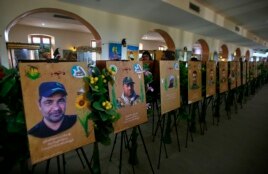17 February, 2019
The capital of Iraq is known for its cultural center and book market. Now, Baghdad has a new place for visitors: a war museum. It honors the thousands of mainly Shiite militiamen who died fighting the Islamic State group.
The museum also shows the Iran-backed militias' growing importance in the country. Their political and military power rose sharply after they helped the government defeat IS. Now they are accused of trying to build their own state within Iraq.
War museum
The museum is housed inside one of Baghdad's historic buildings. It shows rocket launchers, drones and other weapons from the four-year fight with IS. Visitors can look through the items taken from the front lines, as well as personal items fighters left behind on the battlefield.
One recent visitor to the museum was a 55-year-old teacher named Umm Hassanin al-Oukeily. She expressed feeling very thankful for the militia. "I feel that Iraq exists because of them," she said. They are like the beating heart of Iraq, she added.

In this Friday, Feb. 1, 2019 photo, a flag of the Islamic State group and some of the weapons they used in battle, are on display in the Popular Mobilization Forces War Museum on al-Mutanabi Street, Baghdad, Iraq. (AP Photo/Khalid Mohammed)
Who are the militia?
The militia are mainly Shiite groups with close ties to Iran. They also include some Christian, Yazidi and Sunni groups. Together they are known as the Popular Mobilization Forces, or "Hashed al-Shaabi" in Arabic.
They appeared following a call in June 2014 by Iraq's top Shiite cleric, Grand Ayatollah Ali al-Sistani. He asked for volunteers to fight against IS. Tens of thousands answered the cleric's call.
At that time, Iraq's military and security forces had collapsed. Islamic State militants had taken the northern city of Mosul, Iraq's second-largest, and much of northern and western Iraq. Islamic State control came dangerously close to Baghdad and Shiite religious lands farther south. Desperate for a defense, the Iraqi government accepted the militias as an important part of the fight against IS.
The militias lost about 7,000 fighters in the war. They came out of the war with the image of an almost holy force protecting Iraq's Shiite Muslim majority.

In this Friday, Feb. 1, 2019 photo, commemorative images of militiamen who died fighting the Islamic State group over the past four years, and their weapons are on display in the Popular Mobilization Forces War Museum on al-Mutanabi Street, Baghdad, Iraq.
Effect of the militia's popularity
Their popularity has helped make the militias a major political and military player following the defeat of IS. Today, militias are present in almost every Iraqi province. In some areas, they are in local government. Pictures of dead fighters are shown in shop windows in Baghdad and other areas.
The 2018 parliamentary elections were the first after the victory over IS. The militias' coalition won 48 seats, making it the second-largest bloc in Parliament. Their wins gave the militias a formal position in politics. Under the new budget, militiamen are for the first time being paid as soldiers.
But the mix of arms and political power is dangerous for Iraq because of its history of sectarian fighting. Iraq's Sunni minority, the military, and the government fear the Shiite militias may control Iraq the way the powerful Revolutionary Guard does in Iran or the militant Hezbollah group in Lebanon.
A Western diplomat in Baghdad who did not want to be named spoke about his concerns. The Shiite militias "are building economic empires, taking control of state reconstruction companies and projects, and developing into economic organizations," he said.
The more than 50 militias in Iraq have up to 140,000 fighters, according to some estimates and the Popular Mobilization Forces itself. They are backed by tanks and weapons, and have their own intelligence agency, operations room and court of law.
In an interview with the Associated Press last month, the leader of one of the most powerful of the militias, Qais al-Khazali, said their existence helps the Iraqi military. He suggested that the militias would remain a force as long as there's an ongoing military threat to Iraq.
I'm Susan Shand.
Susan Shand adapted this story for Learning English based on an original report from the Associated Press. Kelly Jean Kelly was the editor.
Write to us in the Comments Section or on 51VOA.COM.
________________________________________________________________
Words in This Story
drone – n. a type of small aircraft that flies without a pilot
booty – n. money or goods stolen or taken in war
cleric – n. a religious man
desperate – adj. having a strong need or desire for something or to do something
sectarian – adj. relating to religious or political sects and the differences between them
empire – n. a group of countries or regions that are controlled by one ruler or one government